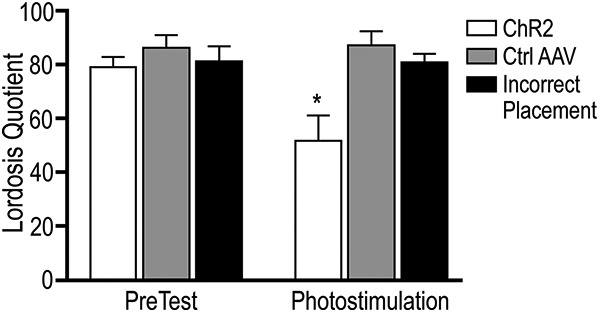Figure 4.

Photostimulation of ChR2 in the MPN significantly attenuates the LQ. A two-way ANOVA followed by Tukey’s multiple comparisons test indicated a significant interaction between virus type and behavior test on the LQ (F(2,28) = 3.96, p = 0.03). Photostimulation of ChR2-expressing fibers in the MPN significantly reduced the LQ as compared to all other conditions (denoted by *). There was no difference in initial sexual receptivity between any of the three groups. In Pomc-cre mice expressing ChR2 in β-End terminals, photostimulation significantly attenuated lordosis (photostimulation, white bar) as compared to the pre-test without photostimulation (pre-test, white bar; simple main effect p = 0.01). Photostimulation of ChR2 (white bar) also significantly reduced the LQ as compared to both mice with the control virus (gray bar, simple main effect p = 0.001) and mice with incorrectly placed fiber optic cannulae (black bar, simple main effect p = 0.03). Photostimulation of ChR2 (photostimulation, white bar) furthermore significantly reduced the LQ as compared to the pre-test LQ of both mice receiving the control virus (pre-test, gray bar, simple main effect p = 0.002) and those with incorrectly placed fiber optic cannulae (pre-test, black bar, simple main effect p = 0.03). Mice that received the control AAV exhibited no difference (p > 0.99) in LQ between the pre-test and during photostimulation, nor did mice expressing ChR2 but with incorrect placement of the fiber optic cannula (p > 0.99). There was no difference in LQ between mice that received the control virus and those with ChR2 but incorrect placement of fiber optic cannulae in any condition. Values are expressed as mean ± SEM.
